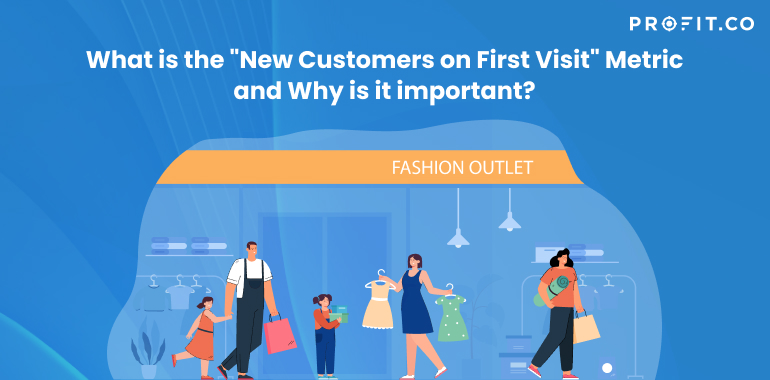Within the array of metrics used to assess customer engagement and loyalty, the “New Customers on First Visit” metric is particularly noteworthy. It offers insight into how well your marketing strategies resonate and the initial attractiveness of your product or service offerings by tracking the rate at which new visitors purchase on their first encounter with your store or website.
Let’s explore why this metric is so important, how to calculate it, and illustrate its value with a real-world example.
What are the New Customers on First Visit Metric?
The “New Customers on First Visit” metric is a key performance indicator (KPI) used by businesses to measure the effectiveness of their marketing strategies, the appeal of their products or services, and the overall customer experience from the first point of interaction.
Specifically, this metric calculates the percentage of new visitors to a store or website who purchase during their first visit.
“We see our customers as invited guests to a party, and we are the hosts. It’s our job every day to make every important aspect of the customer experience a little bit better.”
Why is the “New Customers on First Visit” Metric Important?
The “New Customers on First Visit” metric is important for several reasons, as it provides businesses with valuable insights into their performance and customer behavior.
Here are the key reasons this metric is crucial:
Marketing Effectiveness
It helps assess the immediate impact of marketing campaigns. A higher number indicates that promotional strategies are successfully attracting and converting prospects.
First Impression Impact
This metric reflects the strength of your brand’s first impression. In competitive markets, capturing customer interest at the first point of contact is crucial.
Customer Experience Insights
Analyzing the behavior of new customers can provide insights into the customer experience and identify potential barriers to conversion.
Product Appeal
Initial purchases can signal the market’s reception to your product offerings, highlighting what works and what might need adjustment.
Not sure where to start? Schedule a free session with our OKR experts!
How a Bad Shopping Experience Can Affect “New Customers on First Visit” Metric?
A bad shopping experience can significantly impact the “New Customers on First Visit” metric, reflecting directly on a business’s ability to attract and retain new customers. 66% of consumers have committed to never shopping with a brand following a bad experience (Sitecore). This metric, which measures the percentage of new visitors who make a purchase on their first visit, is a crucial indicator of the effectiveness of a business’s marketing strategies, the appeal of its products or services, and the overall customer experience. Here’s how a negative shopping experience can affect this metric:
Lower Conversion Rates
A poor shopping experience be it due to complicated navigation, slow website performance, insufficient product information, or a difficult checkout process can deter first-time visitors from completing a purchase. This directly lowers the “New Customers on First Visit” conversion rate, as fewer new visitors turn into buyers.
Damage to Brand Perception
First impressions are vital. A negative initial shopping experience can harm your brand’s reputation in the eyes of potential customers. This not only affects immediate conversion rates but can also have long-term repercussions on customer loyalty and word-of-mouth referrals, crucial components of sustainable business growth.
Increased Bounce Rates
When new visitors encounter a bad shopping experience, they are more likely to leave the site without engaging further. This increases the bounce rate, indicating that the business is not meeting the needs or expectations of its visitors, which can be particularly damaging when trying to attract new customers.
Negative Reviews and Social Media Impact
Dissatisfied customers are more likely to share their negative experiences online, through reviews or social media, than positive ones. This public feedback can deter potential new customers from visiting, thus indirectly affecting the “New Customers on First Visit” metric by reducing the number of new visitors willing to give the business a chance.
Reduced Customer Lifetime Value
The initial shopping experience sets the tone for a customer’s entire relationship with a brand. A bad first experience can significantly reduce the likelihood of customers returning, directly impacting the potential lifetime value they bring to the business. Even if they make a purchase, their overall perception and satisfaction are likely to influence their future decisions.
Addressing the Impact
To mitigate the negative effects of a bad shopping experience on new customers, businesses must:
- Continuously monitor and optimize the user experience, ensuring the shopping process is as smooth and intuitive as possible.
- Gather and act on customer feedback to address issues promptly.
- Implement clear, responsive customer support channels to assist customers through any difficulties they encounter during their first visit.
Improving the shopping experience for new visitors not only boosts the “New Customers on First Visit” metric but also lays the foundation for building a loyal customer base and enhancing overall business performance.
Formula for Calculating “New Customers on First Visit”
The formula for calculating this metric is straightforward yet insightful:

This calculation gives you a percentage that represents the efficiency with which your business converts new visitors into paying customers.
Real-life Example: A Boutique Clothing Store
Let’s apply this metric to a boutique clothing store that recently launched an online shopping website. The store has been promoting its website through social media ads, aiming to attract new customers.
Data Collection: Over the first month, the website analytics show that 2,000 new visitors landed on the site, out of which 400 were purchased on their first visit.
Calculation:
New Customers on First Visit = ( 400/ 2000 )×100=20%
Analysis
A 20% conversion rate for new customers on their first visit is quite impressive for a boutique store just venturing into online sales. This suggests that the marketing strategies employed are effective in attracting the target audience, and the store’s online presentation (including product listings, user experience, etc.) is compelling enough to convert a significant portion of new visitors into buyers.
Actionable Insights
With this metric in hand, the store can now delve deeper into understanding which marketing channels are the most effective, what products new customers are purchasing, and how the overall online shopping experience can be enhanced to maintain or improve this conversion rate. Furthermore, comparing this metric over time can help the store identify trends, seasonality effects, or the impact of specific marketing campaigns.
How OKRs Can Measure New Customers on the First Visit Metric?
Creating Objectives and Key Results (OKRs) focused on improving the “New Customers on First Visit” metric is a strategic way to drive targeted improvements in marketing effectiveness, customer experience, and overall business growth. Below is an example of how OKRs for this metric might be structured, including objectives, and specific initiatives to achieve the goals.
Objective: Enhance the Conversion Rate of New Customers on Their First Visit
- KR 1: Increase the “New Customers on First Visit” conversion rate from 15% to 25% within the next quarter
- KR 2: Improve the first-visit customer experience score from 7.0 to 8.5 (out of 10) as measured by customer surveys
- KR 3: Increase the percentage of new visitors purchasing on their first day from 10% to 20%
Initiatives:
- Optimize landing pages with A/B testing to identify and implement the most effective designs and messaging.
- Implement a feedback loop with customers to gather insights on their first-visit experience and identify areas for improvement.
- Introduce targeted social media and email marketing campaigns to drive first-time visits with a high intent to purchase.
Conclusion
The “New Customers on First Visit” metric is a powerful tool in the arsenal of business analytics. It not only measures the immediate effectiveness of marketing and product appeal but also serves as a stepping stone for deeper customer behavior analysis. By understanding and improving upon the factors that influence this metric, businesses can strategically enhance their customer acquisition efforts, ultimately leading to sustained growth and success.
Ready to start your journey to optimizing your business
Related Articles
-
ARR Multiple: A Key Metric for SaaS Valuation
In the Software-as-a-Service (SaaS) Industry, understanding how a company is valued is crucial for both founders and investors. One metric... Read more
-
Abandoned Checkouts: Why They Happen and How to Fix Them
In e-commerce, few challenges are as persistent and as costly as abandoned checkouts. Despite a shopper's clear intent to buy,... Read more
-
From Baseline to Target: Mastering the Science of KPI Progress
KPIs (Key Performance Indicators) are more than just numbers on a spreadsheet they're the compass that guides your business toward... Read more
-
Understanding Planned Value and Its Importance in Project Management
In project management, monitoring and measuring progress are essential to ensuring that projects stay on track and deliver expected results.... Read more

